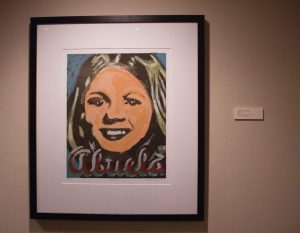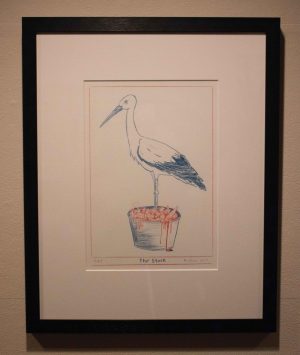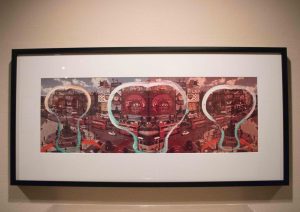Exhibit views life from human perspective
Jan 24, 2019
The narcissism of our species is on full display in the latest UNI Gallery of Art show, “In and Of the Anthropocene,” co-curated by gallery director Darrell Taylor and art history professor Elizabeth Sutton. The exhibit can be found in the Mary Haskell-Hansen Room and features work from UNI’s permanent art collection.
“Abuela,” a screenprint by Texan artist Paul Valadez makes its UNI debut in this show. The exhibition also includes artworks by American artist Mark Dion, whose pieces were completed in the UNI Printmaking Labs under the direction of professors Tim Dooley and Aaron Wilson. British printmaker Elisabeth Frink, Chicago artist Phyllis Branson, San Diego artist Suda House and Zimbabwean artist Fanizani Akuda also appear in the show, along with screenprints by Korean ceramicist Sunkoo Yuh and a large-scale woodcut by Hannah March Sanders, printmaking area head at Southeast Missouri State University.
From a drum sculpture to a lithograph print, the exhibited works are as diverse in medium as they are in origin.
“In order to mark humans’ profound impact to the Earth and its organisms, Dutch chemist Paul Crutzen popularized the term ‘Anthropocene’ to denote a new geological epoch,” Sutton said. “The art selected for this exhibition suggests varieties of life from a human perspective, and it provides views into spaces, pre- and post-human. Thus, art, as ever, can serve as a reflection of our narcissism as a species.”
Sutton and Taylor collaborated to select works from UNI’s permanent collection that suggest themes such as identity, time, memory, environment, language, spirituality and more. Students in Sutton’s fall course named “Late 20th Century and Contemporary Art” used the art as a springboard to investigate these themes. While these concepts may be anthropocentric, ultimately Sutton expressed hopes that “the show prompts viewers to consider the significance of other ways of being – beyond the human.”
The UNI Gallery of Art’s permanent collection includes around 4,000 art objects spanning centuries from around the globe. Pieces from this collection are featured throughout campus, in this show and in the gallery’s other current exhibition, “An Art Collection Travelogue.”
“In and of the Anthropocene” will be shown Jan. 14 through March 2, March 25 through April 20 and April 29 through May 11.
The UNI Gallery of Art is free and open to the public. Their hours are 10 a.m. to 7 p.m. from Monday through Thursday, noon to 5 p.m. on Friday and Saturday and by appointment.














